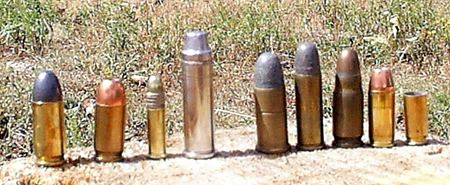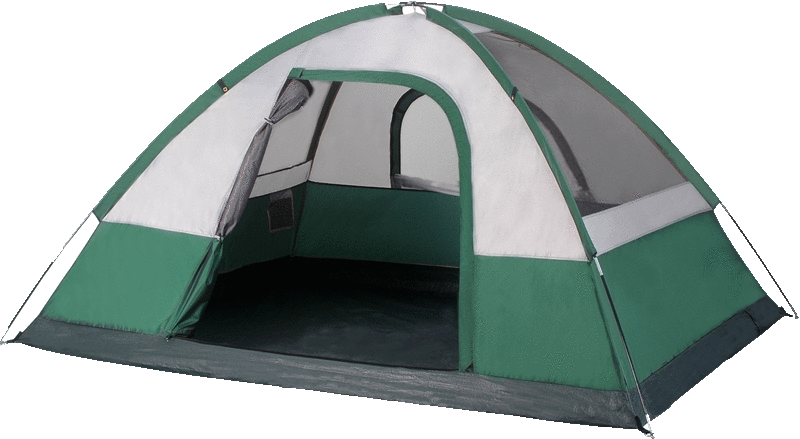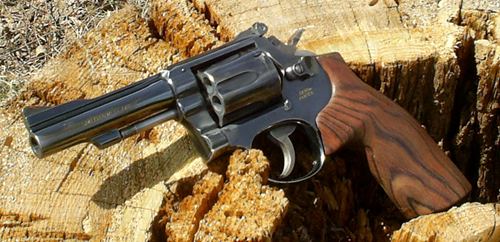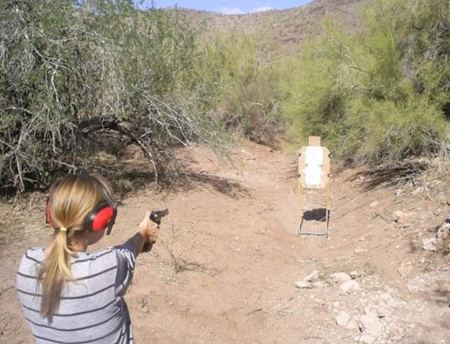At first look you’ll notice nothing special about this revolver.
So, is it? Maybe I should even provide a detailed description of what a
revolver is!?
I mean, come on, autoloaders are all the rage these days. New ones,
certainly new variations of an existing version come on the market constantly.
Can you name a firearms manufacturer who does not offer a Model 1911 auto?
So, who cares about a beaten-up ex-duty sidearm that has this silly feature
of six cartridges arranged in a cylinder? I wonder if, soon, it may qualify
as a ‘primitive’ weapon!
But listen up – unless you cough up serious dough for a custom auto, there is
one sensation that ought to put a smile on your face … squeezing the single
action trigger on a S&W revolver!
And even though a mundane .38 special cartridge towers dimensionally over the
oh-so-common wonder-nine, recoil from a Model 15 is not worth writing about.
Just cock the hammer and shoot again.

A .38 special towers over, from left, 9mm Luger,
380 Auto and 22 lr. Also squeezing into the picture was such riff raff like 38
S&W, 32 S&W Long, 7.65 Luger, 32 Auto and an empty .25 Auto.
|
When I several years ago acquired this beaten-up old S&W at a gun show, it was
because I had collected a bunch of .38 Special brass by way of finding them on
the desert floor. Dies were already on hand, and lead projectiles (then,
anyway) were cheap. So I wanted a gun to shoot that stuff with. This old
service horse, ailing with severe holster wear, was perfect for the job because
it didn’t devastate my bank account.
After ripping countless 9mms through a Beretta (with its mushy double-action
trigger), the S&W trigger delighted immediately. ‘Punching paper’ all of a
sudden was a relaxing fun activity. Yes, the Model 15 produced! Bullet holes
appeared where the sights told them to. All this happened without much blast
or recoil.
The old revolver now earns its occasional place on my hip when I go where a
sudden target of opportunity may prevent installation of earplugs. Like on
camping trips.
For instance, last October I could not stop myself when an Abert squirrel
‘challenged’, resting quite high on a sizeable branch, smirking its little
round, bucktoothed face at me. After careful aim the little rodent instantly
changed its composure when the 158 grain slug ripped a chunk of bark out off
the pine branch right next to fur. The squirrel hurried to a nearby branch,
apparently failing to properly assess its situation.
Expecting the little punk to scamper off any time I rushed my next shot and
missed again. Now bushytail was on the move with more purpose. But when it
paused a third time, the Special connected and launched him. In case you
wondered, squirrel tastes surprisingly pleasant after being roasted over an
oak-coal camp fire. Meat destruction from a .38 is not a problem.
As another aside, if you’re up to it, a great way to hunt squirrels is to
‘run them down’ when you see one scampering around on the forest floor.
Honestly, run at them as fast as you can. For sure this will tax your lungs
at the altitudes we encounter them here in Arizona. Such a charge, however,
will make them tree. And usually they’ll rest on a branch not too high up,
probably to get a closer look at the storming idiot who just interrupted their
daily routine. At which point I can catch my breath and then take a well-aimed
shot. Obviously, this method works even better if someone else chases the
critter up a tree for you.
Few will argue that the .22 rimfire is the king of plinking. Also, guys, let’s
be honest, occasionally we like to destroy stuff. A .38 Special has a place
here. In comparison to rimfire 40 grain hollow points, those 158 grain semi
wadcutters from a thirty-eight punch larger holes through cardboard, knock down
heavier steel plates, bounce cans further, throw up more dust, send fresh cow
patties flying further (best step back a little more), and no doubt rip more
splinters out of wood. They do all this without a hurtful increase in recoil
or noise. Plus, a Model 15 offers surprising precision. When’s the last time
six shots left a single ragged hole in your target?
Ok, if we sum things up, “Special” equates to cheap fun, no-fatigue shooting,
accurate bullet placement, even camp meat. Furthermore, a .38 Special is an
honest tool for personal defense. Some may argue that it’s the absolute
minimum. Whatever, it clearly is far superior to any twenty two, .380 auto,
or anything in between.
If you’d like, you can take this a step further. With about four speed
loaders and round-nosed ammo I seriously doubt you’d come in last in our
club’s practical pistol events.
Maybe here’s a good place to talk about the ammo. The industry provides a
ton of loading data for the .38 Special. There’s no point to go over all
that again. I followed that approach when I loaded for my Model 15.
Winchester 231 was on hand, so 4.5 grains of it went into my cases, topped
by the almost classic 158gr semi wadcutter lead bullet.
This recipe shot good enough right from the get-go. So I stuck with that,
rather than setting out to split an accuracy hair, or squeeze another foot
per second from the worn ‘Smith’. Now, if I would seriously pursue practical
pistol performance, that is, increase scores in our events, lighter bullets
(for less recoil), and possibly other powders which generate the least amount
of smoke may have merit. In that scenario some more experimentation might be
worthwhile. Ditto would I pursue more speed if self-defense were to play a
more dominant role.
This also bridges to where the .38 is perhaps most special – in the hands of
beginners, youngsters or women. From my own experience with this very Model
15 and the aforementioned ammo, those novices have enjoyed shooting this
revolver, and certainly not minded whatever recoil and noise it belched out
when they pulled (oh, I know, they should “squeeeeze”) the trigger.
On average, the balance of a revolver with more weight forward, the shape of
its grip and that crisp trigger make it easier to hit what we aim at. So a
beginner gets positive feedback when bullet holes appear in the A-zone with
satisfying regularity.
Even better, a revolver works great as a flinch detector. After all rounds
in the cylinder are fired, take the gun from the novice (or any shooter, for
that matter) and load it only with some live rounds, leaving a few empty
cases in there). Then watch the movement of the gun as the shooter fires or
attempts to fire. A flinch occurs in the form of a sudden barrel downward
jerk, in anticipation of noise and recoil. Then inject a short session of
dry-firing to eradicate such jerking trigger pulls. If that won’t cure,
maybe further down-loaded ammo will, something that would never function in
a semi.
In an era where high-capacity autoloaders rule – and who would argue that
they are both fun and practical – don’t dismiss a plain old wheelgun. It is
a compromise in some ways, like size and weight, and may be a handicap in
others, like fast seconds shots and firepower. But it still has a special
place in our world of shooting.

![]()





